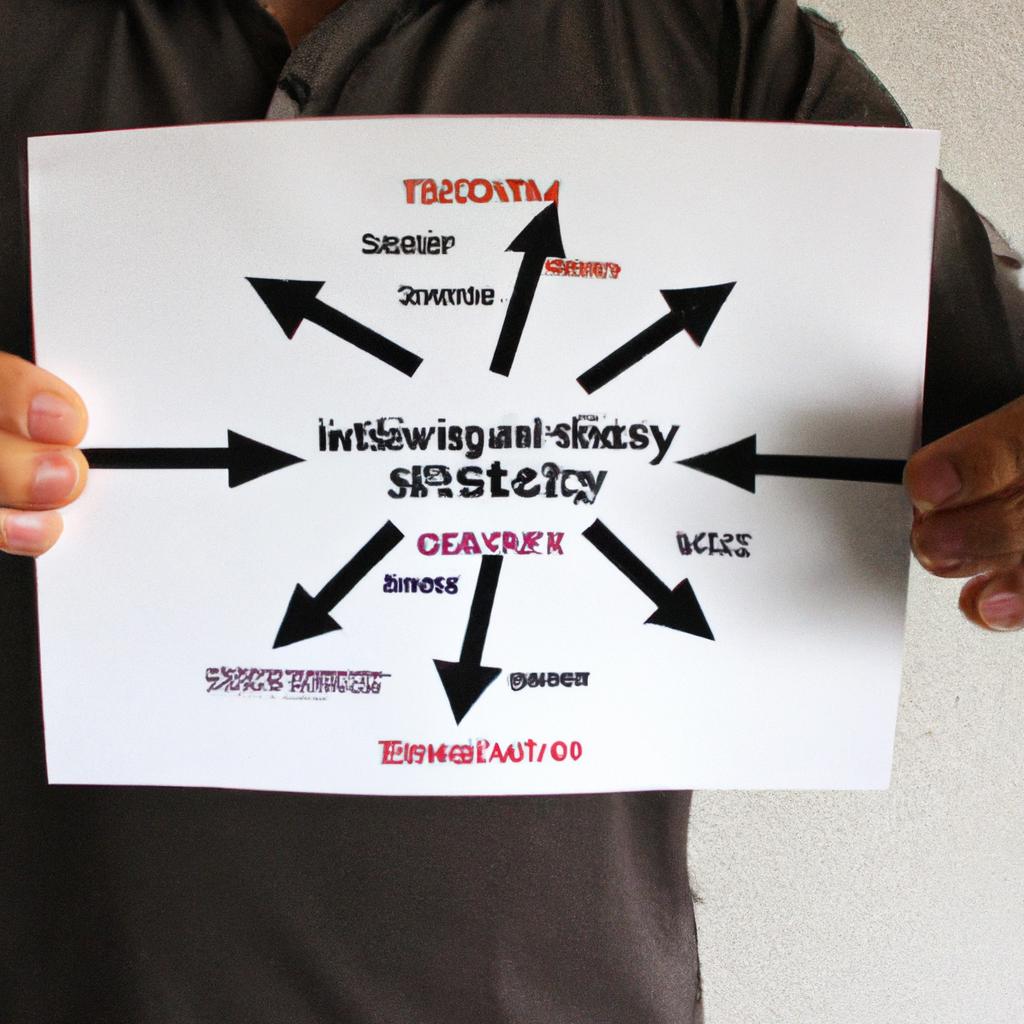In today’s highly competitive business landscape, effective marketing and advertising play a crucial role in determining the success of any product or brand. To stand out from the crowd and capture the attention of consumers, companies need to strategically position their products in the market. This is where Unique Selling Proposition (USP) comes into play – a powerful tool that helps businesses differentiate themselves from competitors and create a distinctive identity in consumers’ minds.
To understand the importance of USP in product positioning, let us consider a hypothetical example: Imagine two smartphone manufacturers launching their latest flagship devices simultaneously. Both phones offer similar features such as high-quality cameras, fast processors, and sleek designs. However, one manufacturer decides to emphasize its USP – long-lasting battery life – while the other fails to establish a clear differentiator. As a result, despite having comparable specifications, the first manufacturer successfully positions its product as an ideal choice for users who prioritize uninterrupted usage over other factors.
This example highlights how effectively utilizing USP can be instrumental in capturing consumer attention and influencing purchasing decisions. In this article, we will delve deeper into the concept of USP within marketing and advertising strategies. We will explore why it is essential for businesses to identify and articulate their unique selling propositions accurately. Furthermore, we will discuss various techniques and approaches that companies can employ to develop a powerful USP. Additionally, we will examine how businesses can effectively communicate their USP to target audiences through different marketing channels.
Understanding the importance of USP begins with recognizing that consumers are constantly bombarded with numerous options in the market. With countless brands competing for attention, consumers tend to gravitate towards products or services that offer something unique and valuable. This is where a well-defined USP becomes critical – it helps businesses convey their distinct advantages and value propositions in a compelling manner.
By establishing a clear USP, companies can position themselves as leaders in specific areas and create a niche within the market. This differentiation not only attracts potential customers but also helps build brand loyalty among existing ones. Moreover, an effective USP enables businesses to charge premium prices for their products or services, as customers perceive them as superior or exclusive.
To develop a powerful USP, businesses must conduct thorough market research and identify gaps or unmet needs within their target audience. By understanding consumer preferences and pain points, companies can tailor their offerings to address these specific requirements better than competitors. This customer-centric approach allows businesses to align their USPs with what matters most to potential buyers.
Once a strong USP is identified, it is crucial for companies to effectively communicate it across various marketing channels. From traditional advertising mediums like television commercials and print advertisements to digital platforms such as social media and email marketing, every touchpoint should reinforce the unique selling proposition. Consistent messaging and branding help reinforce the desired perception in consumers’ minds.
In conclusion, developing a Unique Selling Proposition (USP) is essential for successful product positioning in today’s competitive business landscape. By identifying and articulating their distinct advantages accurately, companies can differentiate themselves from competitors and capture consumer attention. Through strategic communication strategies, businesses can effectively convey their unique selling propositions across various marketing channels, ultimately influencing purchasing decisions in their favor.
Understanding USP: The Foundation of Effective Marketing
In today’s highly competitive marketplace, businesses face the challenge of standing out from their competitors and capturing the attention of consumers. This is where Unique Selling Proposition (USP) comes into play. A USP refers to a distinct feature or benefit that sets a product apart from others in the market. By clearly communicating this unique value proposition, companies can effectively position their products and create a lasting impression on consumers.
Example Case Study:
To illustrate the power of USP, let us consider an example case study. Company X, a startup specializing in organic skincare products, faced tough competition from well-established beauty brands. However, by emphasizing its commitment to using only natural ingredients sourced directly from local farmers, Company X developed a strong USP that resonated with health-conscious customers seeking environmentally friendly options. Through targeted marketing campaigns highlighting its sustainable practices and superior quality, Company X successfully differentiated itself within the crowded skincare industry.
Eliciting an Emotional Response through Bullet Points:
- Increased brand recognition
- Enhanced customer loyalty
- Improved sales performance
- Greater market share
Eliciting an Emotional Response through Table:
| USPs | Benefits | Examples |
|---|---|---|
| Quality | Assurance of superior product performance | Luxury car brands advertising durability |
| Affordability | Cost-effective option for budget-conscious | Discount retailers promoting low prices |
| Convenience | Time-saving solutions for busy individuals | Online platforms offering fast delivery |
| Innovation | Cutting-edge technology for improved outcomes | Tech companies showcasing new features |
Transitioning to Identifying Your Target Audience: The First Step in USP Development:
By understanding how USPs contribute to effective marketing strategies, it becomes evident that identifying your target audience is crucial in developing a compelling USP tailored specifically to their needs and preferences. Through comprehensive market research and analysis, businesses can gain valuable insights that will shape their USP and ultimately drive success in the competitive marketplace.
Identifying Your Target Audience: The First Step in USP Development
The Power of USP: The Key to Effective Marketing and Advertising in Product Positioning
In the previous section, we explored the concept of Unique Selling Proposition (USP) and its significance in effective marketing strategies. Now, let us delve deeper into the process of identifying your target audience as a crucial step in developing an impactful USP.
To illustrate this point, consider a hypothetical scenario where you are launching a new line of skincare products specifically designed for individuals with sensitive skin. By conducting thorough market research, you discover that there is a significant portion of consumers who struggle to find suitable skincare options due to their sensitivity. This insight serves as a starting point for creating your USP – addressing the needs of this underserved target audience.
When it comes to defining your target audience, there are several key factors to consider:
- Demographics: Understanding the age range, gender distribution, income level, and geographic location can help tailor your messaging appropriately.
- Psychographics: Analyzing customers’ lifestyle choices, values, interests, and personality traits provides insights into their motivations and preferences.
- Pain Points: Identifying common challenges or frustrations faced by potential customers allows you to position your product as a solution.
- Competitor Analysis: Assessing competitors targeting similar customer segments helps identify gaps or areas for differentiation.
By utilizing these essential steps in identifying your target audience, you can develop a comprehensive understanding of their needs and desires. Once armed with this knowledge, crafting a compelling USP becomes more attainable.
Continuing our exploration into effective marketing practices, analyzing competitors plays a pivotal role in uncovering opportunities for differentiation within your industry landscape.
Analyzing Competitors: Uncovering Opportunities for Differentiation
In order to effectively position your product or service in the market, it is crucial to identify your target audience. Understanding who your ideal customers are and what they want allows you to tailor your messaging and offerings specifically to meet their needs. This step serves as the foundation for developing a Unique Selling Proposition (USP) that will resonate with your target audience and differentiate you from competitors.
For instance, let’s consider a hypothetical case study of a fitness apparel company targeting young professionals who value both style and functionality in their workout gear. By conducting market research and analyzing consumer trends, the company discovers that this particular demographic seeks athletic clothing that combines performance features with trendy designs suitable for wearing outside of the gym. Armed with this information, the company can now craft a more targeted USP that highlights its unique ability to offer stylish activewear without compromising on quality or performance.
To further emphasize the significance of identifying your target audience, here are key points to keep in mind:
- Understanding customer preferences: Identifying your target audience enables you to gain insight into their preferences, interests, and buying behaviors. This knowledge helps shape not only your marketing messages but also product development decisions.
- Tailoring marketing efforts: Once you have identified your target audience, you can customize your advertising campaigns to speak directly to them. By using language, imagery, and channels that resonate with their values and aspirations, you increase the likelihood of capturing their attention and gaining their trust.
- Building emotional connections: When you understand your target audience deeply enough to know what matters most to them, you can create an emotional connection through storytelling and relatability. This connection fosters brand loyalty among consumers who feel understood and valued by companies that prioritize meeting their specific needs.
- Maximizing return on investment: Precisely defining your target audience ensures that you allocate resources strategically rather than wasting time and money on reaching people who are unlikely to be interested in what you offer. This targeted approach allows for more efficient marketing efforts, ultimately resulting in a higher return on investment.
Consider the following table that highlights the benefits of identifying your target audience:
| Benefits of Identifying Your Target Audience |
|---|
| 1. Improved understanding of customer preferences |
| 2. Tailored marketing campaigns specific to their needs |
| 3. Emotional connection through relatability |
| 4. Maximizing return on investment |
By identifying your target audience, you can lay the groundwork for developing an effective USP that sets you apart from competitors and resonates with your ideal customers’ desires and aspirations. Crafting a compelling USP goes beyond simply stating what makes your product or service unique; it involves creating a message that is memorable, persuasive, and aligned with your brand values.
Crafting a Compelling USP: Creating a Unique and Memorable Message
Having thoroughly analyzed your competitors, it is now time to identify the gaps in the market and uncover opportunities for differentiation. By doing so, you can position your product or service uniquely and effectively, ensuring that it stands out in a crowded marketplace.
Let us consider an example to illustrate this concept. Imagine a hypothetical scenario where two coffee shops, Aroma Brews and Daily Grinds, are competing for customers in the same neighborhood. Both offer high-quality coffee beverages and cozy atmospheres, making their offerings seemingly similar. However, upon closer examination of their target markets and customer preferences, Aroma Brews discovers an untapped opportunity – there is a growing demand for organic coffee among health-conscious individuals in the area.
To capitalize on this potential differentiator, Aroma Brews decides to craft its unique selling proposition (USP) around using only organic beans sourced from local farmers. This decision not only sets them apart from their competitor but also appeals directly to their target audience’s desire for healthier options. By recognizing this opportunity through competitor analysis, Aroma Brews can effectively position itself as the go-to destination for those seeking organic and sustainably sourced coffees.
When identifying opportunities for differentiation based on competitor analysis, consider the following factors:
-
Target Market Preferences:
- Understand what specific needs or desires are unmet within your target market.
- Identify any emerging trends or shifts in consumer behavior that could present new possibilities.
-
Unique Features or Benefits:
- Evaluate your product/service offering against your competitors’.
- Determine if there are any distinct features or benefits you possess that others do not.
-
Brand Personality:
- Assess how your brand is perceived by consumers.
- Look for ways to differentiate yourself through branding strategies such as messaging tone or visual identity.
-
Customer Experience:
- Examine the entire customer journey from discovery to post-purchase.
- Identify areas where you can enhance the overall experience and set yourself apart.
By carefully considering these factors during your competitor analysis, you can uncover opportunities for differentiation that will allow your product or service to shine in the marketplace.
[Transition sentence]: Now that we have identified opportunities for differentiation through competitor analysis, let us explore how to craft a compelling unique selling proposition (USP) that resonates with your target audience.
Communicating Your USP: Strategies for Effective Marketing and Advertising
Crafting a compelling USP is just the first step in effective marketing and advertising. Once you have created a unique and memorable message, it is essential to effectively communicate your USP to your target audience. By employing various strategies in your marketing and advertising efforts, you can ensure that your USP resonates with consumers and drives them towards choosing your product or service.
One example of successfully communicating a USP can be seen in the case study of a skincare brand that prides itself on using all-natural ingredients. To convey their commitment to natural products, they employed several strategies:
- Consistent Messaging: The brand consistently emphasized its use of natural ingredients across all marketing channels, including social media posts, website content, and packaging design.
- Storytelling: They shared stories about the sourcing process for their ingredients, highlighting ethical practices and community involvement.
- Influencer Partnerships: Collaborating with influencers who aligned with their values allowed the brand to reach a wider audience while maintaining authenticity.
- Educational Content: Creating informative blog posts and video tutorials helped educate customers about the benefits of natural skincare, reinforcing their USP.
To further illustrate how different strategies contribute to effective communication of a USP, consider the following table:
| Strategy | Description | Example |
|---|---|---|
| Emotional Appeals | Evoke specific emotions through storytelling or imagery | Using heartwarming narratives to highlight impact |
| Visual Elements | Utilize visually appealing designs and branding elements | Incorporating vibrant colors and eye-catching graphics |
| Targeted Ads | Tailor advertisements based on customer demographics or interests | Displaying ads specifically designed for parents on parenting websites |
| Personalization | Customize messaging according to individual customer preferences or behaviors | Sending personalized emails addressing specific pain points |
By implementing these strategies, businesses can evoke an emotional response from consumers, making their USPs more memorable and impactful.
Understanding the effectiveness of your marketing and advertising efforts is crucial in refining and optimizing your USP for better results.
Measuring Success: Evaluating the Impact of Your USP
Section Title: Maximizing Your USP’s Impact: Leveraging Emotional Appeal in Marketing and Advertising
Building on the strategies discussed earlier, effectively communicating your Unique Selling Proposition (USP) requires a deep understanding of how to tap into consumers’ emotions. By leveraging emotional appeal in marketing and advertising, you can create a powerful connection with your target audience that not only captures their attention but also motivates them to take action. To illustrate this concept, let’s consider a hypothetical case study of a beauty brand introducing a new skincare line targeting millennials.
Case Study Example:
Imagine a beauty brand launching its latest skincare line specifically designed for millennials. The company identifies its USP as using all-natural ingredients sourced sustainably. In order to maximize the impact of this USP through emotional appeal, several key strategies can be employed:
- Storytelling: Craft compelling narratives around the brand’s commitment to sustainability and environmental consciousness. Share stories about how these natural ingredients are ethically harvested, emphasizing the positive impact on local communities.
- Personalization: Tailor messaging to resonate with millennials by highlighting the benefits they value most – such as promoting healthy living or preserving nature for future generations.
- Visuals: Utilize visually appealing imagery that portrays young individuals enjoying outdoor activities while showcasing their radiant skin after using the product.
- Social Proof: Incorporate testimonials from influential bloggers or social media influencers who align with the brand’s values and have experienced positive results from using the skincare line.
| Emotional Trigger | Examples |
|---|---|
| Fear | Highlighting negative consequences associated with not using the product; e.g., premature aging due to exposure to harmful chemicals |
| Happiness | Showcasing individuals experiencing joy and confidence after incorporating the product into their daily routine |
| Belonging | Emphasizing how using the product creates a sense of community and connection with like-minded individuals |
| Nostalgia | Associating the brand with memories or emotions from childhood, creating a nostalgic appeal |
By implementing these strategies and incorporating emotional triggers in marketing materials, the beauty brand can effectively communicate its USP to millennials. However, it is crucial to remember that successful execution hinges on maintaining authenticity and consistency throughout all touchpoints.
In conclusion, when maximizing your USP’s impact through emotional appeal, understanding your target audience and tailoring messaging accordingly is paramount. By crafting compelling narratives, incorporating visually appealing imagery, leveraging social proof, and evoking specific emotional triggers such as fear, happiness, belongingness, or nostalgia, you can create strong connections that resonate deeply with consumers. Implementing these strategies will not only capture attention but also inspire action among your target market.









